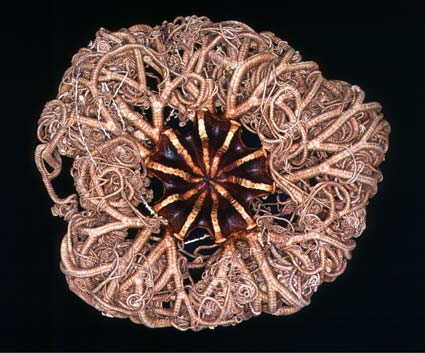

When the core becomes primarily iron, the star's nuclear reaction can no longer continue. Eventually, these elements are transformed into calcium, iron, nickel, chromium, copper and others until iron is formed. If the star is massive enough, it will continue until it converts carbon and oxygen into neon, sodium, magnesium, sulfur and silicon. When the star's supply of hydrogen is used up, it begins to convert helium into oxygen and carbon. In the process, an incredible amount of energy is released. This forms a helium atom and an extra neutron. Deep within the star, A deuterium atom combines with a tritium atom. Deuterium contains one neutron while Tritium contains two. There are two isotopes of hydrogen, which also contain one proton, but contain neutrons as well. A standard hydrogen atom has one proton in its nucleus. Fusion takes place when the nuclei of hydrogen atoms with one proton each fuse together to form helium atoms with two protons.

It is this nuclear reaction that gives a star its energy. The nuclear reactions inside convert hydrogen into helium by means of a process known as fusion. The lower a star is in the sky, the more it will twinkle because its light must pass through more of the atmosphere.Ī star is like a gigantic nuclear furnace. This is what causes the twinkling effect in stars. The effect is similar to what takes place on a hot summer day when you look across hot pavement or a parking lot. This phenomenon is a result of atmospheric interference. The coolest stars are identified as class M and are red in color.Ĭontrary to popular belief, stars do not actually twinkle. Class O stars are the hottest and are blue in color. These classes are O, B, A, F, G, K, and M. They are divided into what are known as spectral classes. Stars are identified by their color, which indicates their temperature. Stars with a magnitude of 8 or more are too dim to see with the naked eye. With a magnitude of -1.46, it is almost 15 times brighter than a star with a magnitude of zero. The brightest star in the night sky is Sirius. Each whole number on this scale is 2.5 times dimmer than the previous number. Astronomers rate the magnitude of a star with a scale that gives brighter stars a low number and dim stars a higher number. A star's brightness is known as its magnitude. It also warms our planet's surface to create a virtual oasis in the coldness of space. The Sun provides energy for nearly every living thing on Earth. They also create the heavy elements that are necessary to form life. They provide the light and energy that fuels a solar system. Stars are the most plentiful objects in the visible universe. Today, the 88 constellations are used by astronomers to organize the night sky and to identify the locations of the stars. These chance alignments of the stars are known as constellations. They identified both animals and people, and each had its own story. Ancient people believed they could see shapes among the stars. For eons, mankind has looked to the heavens and wondered at the lights in the sky.


 0 kommentar(er)
0 kommentar(er)
